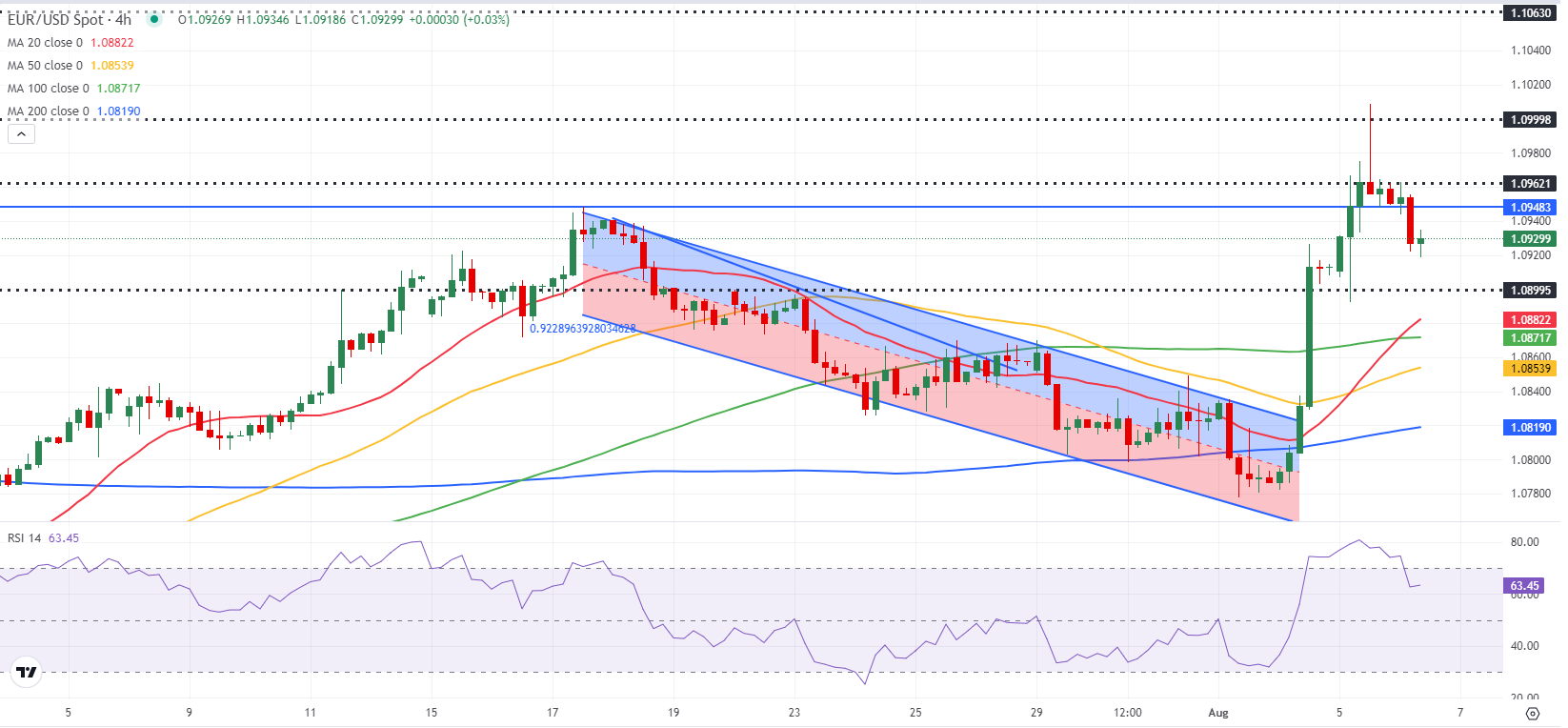- EUR/USD edges lower in the European morning on Tuesday.
- The pair could face the next near-term support at 1.0900.
- In the absence of high-tier data releases, investors will remain focused on geopolitics.
After climbing above 1.1000 for the first time since early January on Monday, EUR/USD erased a portion of its gains but managed to close the day in positive territory. Early Tuesday, the pair stages a technical correction and trades below 1.0950.
Euro PRICE This week
The table below shows the percentage change of Euro (EUR) against listed major currencies this week. Euro was the strongest against the British Pound.
| USD | EUR | GBP | JPY | CAD | AUD | NZD | CHF | |
|---|---|---|---|---|---|---|---|---|
| USD | -0.16% | 0.57% | -1.02% | -0.25% | 0.17% | 0.40% | -0.39% | |
| EUR | 0.16% | 0.65% | -1.00% | -0.21% | 0.35% | 0.46% | -0.34% | |
| GBP | -0.57% | -0.65% | -1.59% | -0.84% | -0.29% | -0.19% | -0.98% | |
| JPY | 1.02% | 1.00% | 1.59% | 0.80% | 1.14% | 1.44% | 0.66% | |
| CAD | 0.25% | 0.21% | 0.84% | -0.80% | 0.46% | 0.65% | -0.32% | |
| AUD | -0.17% | -0.35% | 0.29% | -1.14% | -0.46% | 0.11% | -0.69% | |
| NZD | -0.40% | -0.46% | 0.19% | -1.44% | -0.65% | -0.11% | -0.79% | |
| CHF | 0.39% | 0.34% | 0.98% | -0.66% | 0.32% | 0.69% | 0.79% |
The heat map shows percentage changes of major currencies against each other. The base currency is picked from the left column, while the quote currency is picked from the top row. For example, if you pick the Euro from the left column and move along the horizontal line to the US Dollar, the percentage change displayed in the box will represent EUR (base)/USD (quote).
The broad market selloff amid escalating geopolitical caused the US Dollar (USD) to come under heavy selling pressure at the beginning of the week. After losing more than 0.5% on Monday, the USD Index clings to daily recovery gains at around 103.00 and doesn't allow EUR/USD to gather bullish momentum, as the market mood improves.
Earlier in the day, the data from Germany showed that Factory Orders rose by 3.9% on a monthly basis in June. This reading followed the 1.6% contraction recorded in May and came in better than the market expectation for an increase of 0.8%. Nevertheless, this data failed to trigger a noticeable market reaction.
The US economic docket will feature Trade Balance data for June later in the day. Investors are likely to ignore this report and stay focused on headlines surrounding the Iran-Israel conflict.
At this point, it's difficult to say whether the USD will be able to benefit from safe-haven flows in case geopolitical tensions re-escalate.
EUR/USD Technical Analysis
1.0900 (psychological level, static level) aligns as first support for EUR/USD before 1.0870 (20-day Simple Moving Average(SMA)) and 1.0830 (200-day SMA). On the upside, interim resistance seems to have formed at 1.0960 (static level) before 1.1000 (psychological level, static level). A daily close above 1.1000 could attract technical buyers and open the door for another leg higher toward 1.1060 (static level).
In the meantime, the Relative Strength Index (RSI) indicator on the 4-hour chart declined below 70 but remained above 60, suggesting that EUR/USD is in a correction phase while keeping the bullish bias.
Euro FAQs
The Euro is the currency for the 20 European Union countries that belong to the Eurozone. It is the second most heavily traded currency in the world behind the US Dollar. In 2022, it accounted for 31% of all foreign exchange transactions, with an average daily turnover of over $2.2 trillion a day. EUR/USD is the most heavily traded currency pair in the world, accounting for an estimated 30% off all transactions, followed by EUR/JPY (4%), EUR/GBP (3%) and EUR/AUD (2%).
The European Central Bank (ECB) in Frankfurt, Germany, is the reserve bank for the Eurozone. The ECB sets interest rates and manages monetary policy. The ECB’s primary mandate is to maintain price stability, which means either controlling inflation or stimulating growth. Its primary tool is the raising or lowering of interest rates. Relatively high interest rates – or the expectation of higher rates – will usually benefit the Euro and vice versa. The ECB Governing Council makes monetary policy decisions at meetings held eight times a year. Decisions are made by heads of the Eurozone national banks and six permanent members, including the President of the ECB, Christine Lagarde.
Eurozone inflation data, measured by the Harmonized Index of Consumer Prices (HICP), is an important econometric for the Euro. If inflation rises more than expected, especially if above the ECB’s 2% target, it obliges the ECB to raise interest rates to bring it back under control. Relatively high interest rates compared to its counterparts will usually benefit the Euro, as it makes the region more attractive as a place for global investors to park their money.
Data releases gauge the health of the economy and can impact on the Euro. Indicators such as GDP, Manufacturing and Services PMIs, employment, and consumer sentiment surveys can all influence the direction of the single currency. A strong economy is good for the Euro. Not only does it attract more foreign investment but it may encourage the ECB to put up interest rates, which will directly strengthen the Euro. Otherwise, if economic data is weak, the Euro is likely to fall. Economic data for the four largest economies in the euro area (Germany, France, Italy and Spain) are especially significant, as they account for 75% of the Eurozone’s economy.
Another significant data release for the Euro is the Trade Balance. This indicator measures the difference between what a country earns from its exports and what it spends on imports over a given period. If a country produces highly sought after exports then its currency will gain in value purely from the extra demand created from foreign buyers seeking to purchase these goods. Therefore, a positive net Trade Balance strengthens a currency and vice versa for a negative balance.
Information on these pages contains forward-looking statements that involve risks and uncertainties. Markets and instruments profiled on this page are for informational purposes only and should not in any way come across as a recommendation to buy or sell in these assets. You should do your own thorough research before making any investment decisions. FXStreet does not in any way guarantee that this information is free from mistakes, errors, or material misstatements. It also does not guarantee that this information is of a timely nature. Investing in Open Markets involves a great deal of risk, including the loss of all or a portion of your investment, as well as emotional distress. All risks, losses and costs associated with investing, including total loss of principal, are your responsibility. The views and opinions expressed in this article are those of the authors and do not necessarily reflect the official policy or position of FXStreet nor its advertisers. The author will not be held responsible for information that is found at the end of links posted on this page.
If not otherwise explicitly mentioned in the body of the article, at the time of writing, the author has no position in any stock mentioned in this article and no business relationship with any company mentioned. The author has not received compensation for writing this article, other than from FXStreet.
FXStreet and the author do not provide personalized recommendations. The author makes no representations as to the accuracy, completeness, or suitability of this information. FXStreet and the author will not be liable for any errors, omissions or any losses, injuries or damages arising from this information and its display or use. Errors and omissions excepted.
The author and FXStreet are not registered investment advisors and nothing in this article is intended to be investment advice.
Recommended Content
Editors’ Picks

AUD/USD: The hunt for the 0.7000 hurdle
AUD/USD quickly left behind Wednesday’s strong pullback and rose markedly past the 0.6900 barrier on Thursday, boosted by news of fresh stimulus in China as well as renewed weakness in the US Dollar.

EUR/USD rebounds on Thursday after midweek pullback
EUR/USD tuned back into the high end on Thursday, getting bolstered by a broad-market selloff in the Greenback. US data that printed better than expected helped to ease concerns of a possible economic slowdown within the US economy looming over the horizon.

Gold holding at higher ground at around $2,670
Gold breaks to new high of $2,673 on Thursday. Falling interest rates globally, intensifying geopolitical conflicts and heightened Fed easing bets are the main factors.

Ethena Labs launches new UStb stablecoin backed by BlackRock's BUIDL token
Ethena Labs announced on Thursday that it has released a new stablecoin product, UStb. The new stablecoin will be fully collateralized by BlackRock's USD Institutional Digital Liquidity Fund and function similarly to a traditional stablecoin.

RBA widely expected to keep key interest rate unchanged amid persisting price pressures
The Reserve Bank of Australia is likely to continue bucking the trend adopted by major central banks of the dovish policy pivot, opting to maintain the policy for the seventh consecutive meeting on Tuesday.

Five best Forex brokers in 2024
VERIFIED Choosing the best Forex broker in 2024 requires careful consideration of certain essential factors. With the wide array of options available, it is crucial to find a broker that aligns with your trading style, experience level, and financial goals.
